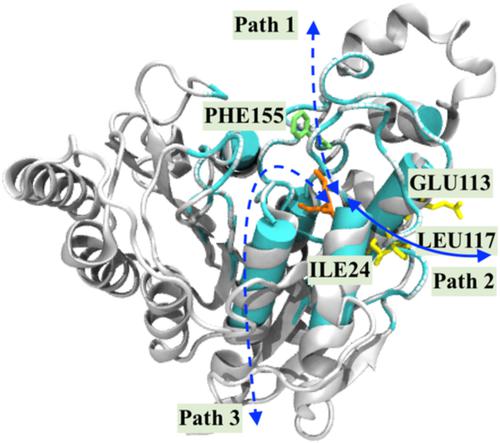当前位置:
X-MOL 学术
›
J. Comput. Chem.
›
论文详情
Our official English website, www.x-mol.net, welcomes your
feedback! (Note: you will need to create a separate account there.)
Mechanistic insights of key host proteins and potential repurposed inhibitors regulating SARS-CoV-2 pathway
Journal of Computational Chemistry ( IF 3.4 ) Pub Date : 2022-05-10 , DOI: 10.1002/jcc.26888 Debabrata Pramanik 1 , Aiswarya B Pawar 2 , Sudip Roy 2 , Jayant Kumar Singh 1, 2
Journal of Computational Chemistry ( IF 3.4 ) Pub Date : 2022-05-10 , DOI: 10.1002/jcc.26888 Debabrata Pramanik 1 , Aiswarya B Pawar 2 , Sudip Roy 2 , Jayant Kumar Singh 1, 2
Affiliation

|
The emergence of pandemic situations originated from severe acute respiratory syndrome (SARS)-CoV-2 and its new variants created worldwide medical emergencies. Due to the non-availability of efficient drugs and vaccines at these emergency hours, repurposing existing drugs can effectively treat patients critically infected by SARS-CoV-2. Finding a suitable repurposing drug with inhibitory efficacy to a host-protein is challenging. A detailed mechanistic understanding of the kinetics, (dis)association pathways, key protein residues facilitating the entry–exit of the drugs with targets are fundamental in selecting these repurposed drugs. Keeping this target as the goal of the paper, the potential repurposing drugs, Nafamostat, Camostat, Silmitasertib, Valproic acid, and Zotatifin with host-proteins HDAC2, CSK22, eIF4E2 are studied to elucidate energetics, kinetics, and dissociation pathways. From an ensemble of independent simulations, we observed the presence of single or multiple dissociation pathways with varying host-proteins-drug systems and quantitatively estimated the probability of unbinding through these specific pathways. We also explored the crucial gateway residues facilitating these dissociation mechanisms. Interestingly, the residues we obtained for HDAC2 and CSK22 are also involved in the catalytic activity. Our results demonstrate how these potential drugs interact with the host machinery and the specific target residues, showing involvement in the mechanism. Most of these drugs are in the preclinical phase, and some are already being used to treat severe COVID-19 patients. Hence, the mechanistic insight presented in this study is envisaged to support further findings of clinical studies and eventually develop efficient inhibitors to treat SARS-CoV-2.
中文翻译:

调控 SARS-CoV-2 通路的关键宿主蛋白和潜在的再利用抑制剂的机制见解
大流行情况的出现源于严重急性呼吸系统综合症 (SARS)-CoV-2 及其新变种,造成了全球医疗紧急情况。由于在这些紧急时刻无法获得有效的药物和疫苗,重新利用现有药物可以有效治疗严重感染 SARS-CoV-2 的患者。寻找一种对宿主蛋白具有抑制功效的合适的再利用药物具有挑战性。对动力学、(解)关联途径、促进药物与靶标进出的关键蛋白质残基的详细机械理解是选择这些重新利用药物的基础。将这一目标作为本文的目标,潜在的再利用药物 Nafamostat、Camostat、Silmitasertib、丙戊酸和 Zotatifin 与宿主蛋白 HDAC2、CSK22、研究 eIF4E2 以阐明能量学、动力学和解离途径。从一组独立的模拟中,我们观察到具有不同宿主-蛋白质-药物系统的单个或多个解离途径的存在,并定量估计了通过这些特定途径解除结合的概率。我们还探索了促进这些解离机制的关键网关残基。有趣的是,我们获得的 HDAC2 和 CSK22 残基也参与了催化活性。我们的结果证明了这些潜在药物如何与宿主机制和特定目标残基相互作用,表明参与了该机制。这些药物中的大多数处于临床前阶段,其中一些已被用于治疗重症 COVID-19 患者。因此,
更新日期:2022-05-10
中文翻译:

调控 SARS-CoV-2 通路的关键宿主蛋白和潜在的再利用抑制剂的机制见解
大流行情况的出现源于严重急性呼吸系统综合症 (SARS)-CoV-2 及其新变种,造成了全球医疗紧急情况。由于在这些紧急时刻无法获得有效的药物和疫苗,重新利用现有药物可以有效治疗严重感染 SARS-CoV-2 的患者。寻找一种对宿主蛋白具有抑制功效的合适的再利用药物具有挑战性。对动力学、(解)关联途径、促进药物与靶标进出的关键蛋白质残基的详细机械理解是选择这些重新利用药物的基础。将这一目标作为本文的目标,潜在的再利用药物 Nafamostat、Camostat、Silmitasertib、丙戊酸和 Zotatifin 与宿主蛋白 HDAC2、CSK22、研究 eIF4E2 以阐明能量学、动力学和解离途径。从一组独立的模拟中,我们观察到具有不同宿主-蛋白质-药物系统的单个或多个解离途径的存在,并定量估计了通过这些特定途径解除结合的概率。我们还探索了促进这些解离机制的关键网关残基。有趣的是,我们获得的 HDAC2 和 CSK22 残基也参与了催化活性。我们的结果证明了这些潜在药物如何与宿主机制和特定目标残基相互作用,表明参与了该机制。这些药物中的大多数处于临床前阶段,其中一些已被用于治疗重症 COVID-19 患者。因此,











































 京公网安备 11010802027423号
京公网安备 11010802027423号